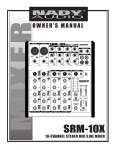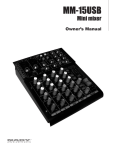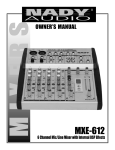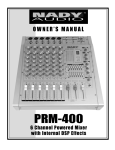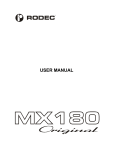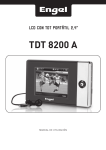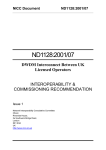Download Nady Systems SRM-10X Musical Instrument User Manual
Transcript
MIXER OWNER’S MANUAL SRM-10X 10-CHANNEL STEREO MIC/LINE MIXER SRM-10X 10-Channel Stereo Mic/Line Mixer Congratulations on your choice of mixers — you have purchased one of the finest compact mixing consoles on the market today. This unit was developed using the expertise of professional sound engineers and working musicians. You will find that your new NADY AUDIO SRM-10X has superior performance and greater flexibility than any other mixer in its price range. Please read this manual carefully to get the most out of your new unit. Date of Purchase Dealer’s Name City State Zip Thanks for selecting NADY AUDIO as your choice in mixing consoles. Model # Serial # CONTENTS WARNING ..........................................................................................................................................................3 FEATURES ...................................................................................................................................................... 4 INSTALLATION.................................................................................................................................................. 5 1. Inspection ...................................................................................................................................................... 5 2. Power Connection.......................................................................................................................................... 5 CONTROLS AND CONNECTIONS .................................................................................................................. 6 1. Mono Input Section ........................................................................................................................................6 2. Stereo Input Section........................................................................................................................................8 3. Master Section ................................................................................................................................................9 a. Aux Sends/Returns Function and Operation .......................................................................................... 9 b. Main Mix Function and Operation ............................................................................................................9 c. Monitor Function and Operation ............................................................................................................10 d. Power Switches ......................................................................................................................................10 4. Connections..................................................................................................................................................11 SPECIFICATIONS............................................................................................................................................ 12 BLOCK DIAGRAM ..........................................................................................................................................13 NOTES ..............................................................................................................................................................14 2 WA R N I N G An equilateral triangle enclosing a lightening flash/arrowhead symbol is intended to alert the user to the presence of uninsulated “dangerous voltage” within the product’s enclosure which may be of sufficient magnitude to constitute a risk of electric shock. ATTENTION: RISQUE DE CHOC ELECTRIQUE NE PAS OUVRIR An equilateral triangle enclosing an exclamation point is intended to alert the user to the presence of important operating and service instructions in the literature enclosed with this unit. IMPORTANT SAFETY INSTRUCTIONS When using this electronic device, basic precautions should always be taken, including the following: 1. Read all instructions before using the product. 2. Do not use this product near water (e.g., near a bathtub, washbowl, kitchen sink, in a wet basement, or near a swimming pool, etc.). 3. This product should be used only with a cart or stand that will keep it level and stable and prevent wobbling. 4. This product, in combination with headphones or speakers, may be capable of producing sound levels that could cause permanent hearing loss. Do not operate for a long period of time at a high volume level or at a level that is uncomfortable. If you experience any hearing loss or ringing in the ears, you should consult an audiologist. 5. The product should be positioned so that proper ventilation is maintained. 6. The product should be located away from heat sources such as radiators, heat vents, or other devices (including amplifiers) that produce heat. 7. The product should be connected to a power supply only of the type described in the operating instructions or as marked on the product. Replace the fuse only with one of the specified type, size, and correct rating. 8. The power supply cord should: (1) be undamaged, (2) never share an outlet or extension cord with other devices so that the outlet’s or extension cord’s power rating is exceeded, and (3) never be left plugged into the outlet when not being used for a long period of time. 9. Care should be taken so that objects do not fall into, and liquids are not spilled through, the enclosure’s openings. 10. The product should be serviced by qualified service personnel if: A. The power supply cord or the plug has been damaged. B. Objects have fallen into, or liquid has been spilled onto the product. C. The product has been exposed to rain. D. The product does not appear to operate normally or exhibits a marked change in performance. E. The product has been dropped, or the enclosure damaged. 11. Do not attempt to service the product beyond what is described in the user maintenance instructions. All other servicing should be referred to qualified service personnel. 3 F E AT U R E S The SRM-10X is the ultimate value in compact professional stereo mic/line mixers. This high quality unit is perfect for home and project studios, live club main and monitor mixing, video post-production studios, remote broadcasting — in fact, anywhere superior performance, rugged reliability and ultra-versatility are needed in an audio mixer. With 10 channels (including 2 stereo AUX returns) and 2 tape inputs, the SRM-10X offers 12 total inputs in all. Features include: • Separate Master Mix, Control Room and Headphone Outputs • Two mono channels with Trim, Bass, Treble, Aux Send, Pan, and Level controls, Low Cut, Pre/Post, PFL switches, and Inserts • Mic and Line Balanced inputs for optimum audio integrity • Four Stereo channels: two with Level controls, Bass/Treble, Balance controls, Pre/Post Aux Send and PFL switches; two with Level controls and PFL switches • 1/4” TRS Stereo Control Room and Headphone outputs • Switchable global +48V phantom power on all mono inputs • Tape In RCA jacks with level control and PFL switch • Input Trim control on each mono channel • Tape Record Out RCA jacks • Pan pots on each mono channel and Balance pots on each stereo input • Individual channel Aux Send, Pre/Post selectable, and Master control • Peak LEDs on Mono channels • Left and Right Main unbalanced outputs with slider control • High-quality pots for all controls with Pan/Balance and EQ controls having center detents • Mono output with slider level control and AFL switch • High-strength steel casing and superior construction with only highest quality components for longest life and maximum reliability • Dual 6-segment LED display bargraph meters • Ultra-low noise mic preamps • External AC supply for optimum signal integrity and superior transient response • Full spectrum frequency response • Wide dynamic range with superior headroom 4 I N S TA L L AT I O N To ensure years of enjoyment from your NADY AUDIO SRM-10X mixing console, please read and understand this manual thoroughly before using the unit. 1. INSPECTION Your NADY AUDIO SRM-10X was carefully packed at the factory in packaging designed to protect the units in shipment. Before installing and using your unit, carefully examine the packaging and all contents for any signs of physical damage that may have occurred in transit. [Please note: Nady Systems is not responsible for shipping damage. If your unit is damaged, do not return to Nady, but notify your dealer and the shipping company (if shipped to you) immediately to make a claim. Such claims must be made by the consignee in a timely manner.] 2. POWER CONNECTION The SRM-10X is designed to operate with the supplied external power supply unit (PSU). Please make sure that the power unit supplied is marked for the correct voltage in your area (120VAC/60 Hz or 230VAC/50Hz). Power requirements for electrical equipment differ from area to area. In new installations and portable sound systems, or any situation in which the AC power is in question, it is wise to confirm the voltage and use the appropriate power supply unit before connecting it to power sources. Check to see that the unit is set to the voltage for your area by referring to the table below: Europe (except UK): 230V, 50Hz UK and Australia: 240V, 50Hz USA and Canada: 120V, 60 Hz For other areas, please check with local authorities. Do not connect the PSU to the SRM-10X while the PSU is connected to the AC mains supply. Connect the switched-off SRM-10X and PSU first before you connect the PSU to the mains supply. Lastly switch on the SRM-10X with the power switch on the back panel. Use only the correct NADY power supply unit to connect the SRM-10X to the Mains AC power. 5 CONTROLS AND CONNECTIONS 1. MONO INPUT SECTION (1) COMBINED MIC XLR / 1/4” LINE INPUT The Mic input is an electronically balanced XLR type designed to accept signals from any balanced low impedance (Low Z) microphone. To accommodate condenser microphones, this input is also equipped with +48VDC phantom power globally switchable to all XLR input jacks with the Phantom Power switch (33). Dynamic or ribbon-type microphones do not require phantom powering. It will be necessary to adjust the channel gain with the input Trim control (3) to achieve a nominal operating level. The XLR jack is configured for: Pin1 = ground, Pin2 = positive (+), Pin3 = negative (-). (1) (2) [Note: The Mic inputs are more sensitive than the Line inputs. Also, do not connect mics with the phantom power switched on, as indicated by the Phantom Power On LED (34) in the Master Section of the front panel. Never use unbalanced mic cables with the Phantom Power switched on. Never short the +48VDC to ground, as that can cause serious damage to your mixer. Also, mute the Monitor/PA speakers when turning the phantom power on or off.] (3) The 1/4” Line input is designed to accept balanced or unbalanced line-level signals such as those from keyboards, drum machines, or samplers. There is enough gain available on the line input to accept even lower level signals, such as those from an unbalanced microphone or guitar output. Use the Trim control (3) to adjust for the desired level. If a balanced signal is to be connected to the line input, then a 1/4" TRS (stereo) phone plug should be wired for: Tip = positive (+), Ring = negative (-), Sleeve = ground. (4) (5) (6) (7) (8) (9) (10) (2) INSERTS Channels 1 and 2 are equipped with insert jacks to connect external signal processors, such as compressors, noise reduction systems, or effects devices, to the individual input channels. Insert points are useful for adding dynamic processing or equalization to a channel. The signal is intercepted post Trim and pre EQ, fed through the external device, then returned to the console at the same point where it left. The insert point is normalized, i.e., the signal is only interrupted when a connector is plugged into it. The insert jack is configured as: Tip = send, Ring = return, Sleeve = ground. (3) TRIM CONTROL The trim control adjusts the input sensitivity (channel gain) of the mic and line inputs on the mono input channels. This control can be adjusted to accommodate input signals from a wide variety of sources, from the high outputs from keyboards or drum machines to the small signal outputs of microphones. This wide range eliminates the need for Mic/Line switching. (11) 6 CONTROLS AND CONNECTIONS The best balance of S/N and dynamic range will be achieved if you adjust the TRIM control on each channel separately so that the Peak Indicator LED (9) for that channel lights occasionally. (7) PRE/POST SWITCH This switch selects whether the AUX SEND signal is Pre or Post Gain control. (Up = Pre, Depressed = Post) (8) PAN CONTROL The Channel Pan positions the output of the channel in the stereo field of the Master Mix. Its constant-power design ensures there are no level discrepancies whether a signal is hard-panned, center-stage, or somewhere in-between. (4) LOW CUT FILTER Use this Low-Cut (high-pass) filter (18 dB/octave, -3 dB at 75 Hz) for reducing floor rumble, popping, breathing noises, woolly bottom end, and to tighten up channels in a mix, etc. It is most effective when used carefully in conjunction with the Equalizer Controls (5). (9) PEAK LED INDICATOR The Peak LED illuminates when a channel is going into overload. It detects the peak level after the EQ and will light at 3dB before clipping to warn that the signal is approaching overload. You do not want the Peak LED to light except very intermittently during a take or a mix. If it does light persistently, reduce input gain with the TRIM control (4). (5) EQUALIZER CONTROLS All mono input channels are fitted with a two-band EQ. All EQs have up to 15 dB of cut and boost, with a center detent for "off". The frequency response is flat when EQ knobs are in the center detent position. The upper and lower shelving controls have their frequencies fixed at 12 kHz and 80 Hz respectively. Remember that the Low Cut filter (4) is an integral part of the overall equalization of a mono channel. The channel EQ is a valuable feature of the mixer as it allows the user to control the tonal characteristics of each instrument separately. For example, boosting the LOW can fatten the sound and add punch to the bass or drums and adjusting the HIGH control can provide a crisp sounding high end. With the LOW set to boost, and the Low Cut switch activated, you get peak response rather than shelving at the bottom end. This is useful for adding warmth to vocals and instruments, and good for tight but deep bass (without losing control of your subwoofer speaker cones). Another very important, yet often overlooked technique is to use the EQ to subtract from the mix. Cutting the HIGH control can reduce unwanted hiss during multi-track recording, while attenuating the LOW can eliminate feedback in a live performance or clear up a muddy sounding mix. Cutting away the top and bottom, then pushing up the Gain is equivalent to mid range boost! (10) CHANNEL GAIN CONTROL The channel gain controls determine the output signal level to the Master Mix bus. (11 & 13) PFL SWITCH Channels 1-10 and TAPE IN channels all have PFL (PreFader Listen). This allows the Meter Display and CONTROL ROOM/HEADPHONE outputs to monitor channel signals Pre channel Gain controls. [Note: When the PFL buttons are depressed, the AUX To Meter switch should be in the off (up) position] [Note: Always reset a channel’s input Gain (or external devices’ output level) after altering the amount of mixer equalization cut or boost applied.] The key to successful equalization is to avoid excess. Too much equalization on the input channels will result in a mix that is smeared together with nothing specifically defined. During rehearsals, experiment with the equalizer controls on various instruments, vocals and combinations of these mixed together to become familiar with various equalizer settings. (6) AUX SEND CONTROLS The Channel AUX SEND is selectable Pre or Post Gain control. For almost all effects send purposes, you will want to use the Post Gain selection, so that when a Gain level is adjusted, any reverb send from that channel will follow the fader. Otherwise, when the fader is pulled down, the reverb from that channel will still be audible. 7 CONTROLS AND CONNECTIONS 2. STEREO INPUT SECTION (12) (25) R LINE INPUT When using channels 3-6 as stereo input channels, the left signal should be connected to the L input and the right signal to the R input. These signals will be routed to the AUX, EQ and Channel Gain controls equally and will retain their stereo separation. The AUX, EQ, BAL, and Channel Gain controls all function the same as those on the mono input channels. When a stereo signal is input to a stereo input channel, these controls will affect the left and right signals equally. (13) The Stereo Line Input jacks are 1/4” unbalanced phone jacks (Tip = positive (+), Sleeve = ground. The input signals to these jacks can be either balanced or unbalanced. (14) (15) (14) EQUALIZERS The stereo channel EQ’s operate in the same manner as those in the mono channels. The left and right signals will be affected equally. A stereo equalizer is generally preferable to using two mono equalizers when equalizing a stereo signal as it avoids possible discrepancies between the left and right settings. (15) AUX SENDS These are the same as for the mono channels. Note that a mono sum is taken from the stereo input. (16) (16) PRE/POST SWITCH This switch selects whether the AUX SEND signal is Pre or Post Gain control. (17) (18) (17) BAL CONTROL For a mono input to the L (MONO) input the function of the control is the same as the PAN controls (8) of the mono channels. However, when a channel is run in stereo, this control functions as a Balance control, determining the relative Balance of the left and right channel signals being sent to the left and right Master Mix buses. For example, with the Balance control turned fully clockwise, only the right portion of the channel’s stereo signal will be routed to the Master Mix. (19) (18) CHANNEL GAIN CONTROL This has the same function as for the mono channels. See MONO INPUT SECTION. (24) L (MONO) LINE INPUT On stereo input channels 3-6, the 1/4" line inputs are designed for stereo or mono line-level signals such as those from keyboards, drum machines, CD players, tape decks, or samplers. However, these inputs can also be used as standard mono line inputs by connecting the signal to the L (MONO) line in. This signal will be routed equally to the BAL control and the left and right outputs in the same way as the mono input channels. For the stereo inputs, the mono channel PAN (8) control is replaced by the BAL (Balance) control. See also BAL Control (17) below. 8 CONTROLS AND CONNECTIONS 3. MASTER SECTION (22) (21) (23) (26) (20) (24) (25) (29) (30) (27) (28) b. Main Mix Function and Operation (23) MONO OUTPUT (26) STEREO OUTPUTS (27) TAPE INPUTS (28) REC OUTPUTS (40) MASTER MIX MONO CONTROL (41) MASTER MIX STEREO CONTROL (36) LED OUTPUT METER a. AUX Sends/Returns Function and Operation (29) STEREO AUX RETURNS LEFT/MONO (30) STEREO AUX RETURNS RIGHT (12) AUX RETURN CONTROLS The Aux Return jacks are the mono or stereo returns for AUX 7-10. If you connect a signal to the Left/Mono Return jack only, the Aux Return will operate in mono and the signal will be routed to the respective Aux Return Control (12) and then mixed into the left and right Stereo Outputs (26). The separate left and right return jacks are provided for use with stereo signals such as those from the output of a stereo effects processor. The left and right return signals will be routed to the AUX Return level controls (12) and mixed into the left and right Stereo Out (26), while maintaining stereo separation. The Aux Returns are multi-functional. They may be used for returning the outputs of effect units, as Tape Returns from a multi-track recorder, or as extra instrument inputs, especially if your MIDI keyboard or rack supplies a pre-mixed stereo signal. The mono sum signal of the Left and Right buses is sent to the Mono output which is controlled by the Mono fader (40). The Stereo Outputs are Left (L) and Right (R) unbalanced 1/4" TRS phone jacks, wired: Tip = positive (+), Sleeve = ground. The REC Outputs (28) also provide an output of the Master Mix. These outputs are RCA jacks, and designed primarily for inputs to tape recorders, etc. The output level routed to the Stereo Outputs and REC Outputs is determined ultimately by the setting of the Master Mix Stereo Control (41). The Master Mix is the sum of the signals routed from all the channels and also the inputs from the AUX return bus and the Tape Input (27). The level of signal from DAT, tape decks, CD players, etc., input to the Tape In (27) is determined by the setting of the Tape In (31) level control. (20) AUX SEND The Aux Send jack is the output for the signal sent from the channel Aux controls (7, 15). It is a 1/4" unbalanced phone jack wired: Tip = positive (+), Sleeve = ground. Master Aux Send levels are adjusted by the Master Aux Send control (37). The 6-stage LED Output Meter (36) displays the Master Mix Stereo, Mono, PFL or AUX send output level. 9 CONTROLS AND CONNECTIONS (31) The SRM-10X allows you to monitor the Master Mix. The signal level is adjusted with the Headphone/Control Room level (39) and routed to both the Control Room (22) and Phones (21) output. The Control Room Output (22) can be connected to an amp to power stereo control room (or other) monitor speakers and is 1/4" stereo jack. Both Control Room (22) and Phones (21) outputs are wired: Tip = left signal, ring = right signal, sleeve = ground. (33) (32) (34) (35) d. Power Switches (43) AC POWER IN SOCKET (44) MAIN POWER SWITCH (35) POWER ON LED INDICATOR Once the external PSU is connected to the AC Power In socket (43) and then to the AC power source, you may switch on your mixer with the Power On switch (44). The Power "ON" LED (35) will light up. Allow 1 minute after powering up for the system to reach equilibrium before setting inputs gains and other levels. (33) PHANTOM POWER SWITCH (34) PHANTOM POWER ON LED INDICATOR When using condenser mics, +48VDC can be switched globally on or off to the XLR mic inputs for all mono channels (also see MONO INPUT SECTION, MIC INPUTS). When this switch is in the "ON" position, the Phantom Power On LED Indicator (34) will light , and +48VDC will be provided between pins 2 and 3 on all the mono Mic input XLR connectors. If you don’t need phantom power, be sure to turn this switch to the "OFF" position. (36) (37) (40) (38) (41) (39) (42) [Note: It is safe to connect balanced dynamic mics or line level devices even if this switch is on, but connecting unbalanced devices or devices whose transformers are center-grounded will cause hum or malfunctions. Shorting the +48VDC can also damage your mixer. Also, mute the Monitor/PA speakers when turning the phantom power on or off.] c. Monitor Function and Operation (38) AUX TO METER AND CTRL R/PHONES (42) AFL SWITCH (22) CONTROL ROOM OUTPUT (21) PHONES OUTPUT (39) PHONES/CONTROL ROOM CONTROL (43) Depressing the AUX TO METER AND CTRL R/PHONES button (38) allows the Aux Send output signal to be directly monitored by the Meter Display and the Control Room / Headphone outputs. This button overrides the AFL switch. (44) [Note: When this button is depressed, all PFL switches should be in the off (up) position] When depressing the AFL switch (42), the Meter Display and Control Room/Headphone outputs will monitor the Mono output signal. BACK PANEL 10 CONNECTIONS This NADY AUDIO console uses 4 different types of audio connectors for the various input/output connections: (1) XLR balanced; (2) 1/4" TRS phone jacks for balanced, unbalanced, stereo, or in/out inserts; (3) 1/4" TRS unbalanced; (4) RCA pin unbalanced Figures 1. Balanced XLR input/output connections 2. Stereo headphone connection with 1/4" TRS plug GROUP & MIX OUTPUTS MICROPHONE INPUTS 3. 1/4" mono (TRS) plug used as unbalanced input/output 2 1 2 1 Ground (Screen) 3 3 4. 1/4" stereo (TRS) plug used as balanced input/output Cold (Out of Phase Signal) 5. 1/4" TRS plug used as Insert Send/Return Hot (In Phase Signal) 6. RCA pin plug for unbalanced input/ouput HEADPHONES Socket (female) UNBALANCED USE OF MONO 1/4” PLUGS Tip = Left signal Tip = Signal Plug (male) BALANCED USE OF STEREO 1/4” PLUGS Tip = hot (+ve) Ring = Right signal Ring = cold (-ve) Sleeve = Ground/Shield Sleeve = Ground/Shield Tip Ring Tip Sleeve Sleeve Strain relief clamp Strain relief clamp 2. Sleeve = Ground/Shield Tip Ring Sleeve 3. 1/4” STEREO PLUG USED AS INSERT SEND/RETURN TIP Send to External Device SLEEVE Ground (Screen) Strain relief clamp 4. RCA PIN PLUG Strain relief clamp Sleeve = Ground (Shield) RING Return from External Device Ring Sleeve Tip 11 5. Pin = Signal 6. 1. S P E C I F I C AT I O N S Setting: MONO OUT, +4dBm/400Hz, All Pots at MID, Master at MAX. 1. INPUT SECTION Input Connector Input Impedance Nominal Level Max Level XLR 1.3K Ω -28 dBm -1.0 dBm MONO CH LINE 1/4" TRS 11K Ω -10 dBm +17 dBm STEREO CH LINE 1/4" TRS 10K Ω -10 dBm +10 dBm STEREO TAPE IN RCA PIN JACKS 10K Ω -9 dBm +8 dBm 1/4" TS 5K Ω -11 dBm +8 dBm MONO CH MIC AUX RETURNS 2. OUTPUT SECTION Output Connector Output Impedance Nominal Level Max Level STEREO OUT L/R 1/4" TS 210 Ω +4.6 dBm +20 dBm AUX SENDS 1/4" TS 210 Ω -22.2 dBm -6.4 dBm CNTRL R. OUT 1/4" TS 22 Ω -19.4 dBm +20 dBm RCA PIN JACKS 1K Ω -10.6 dBm +4.8 dBm 1/4" TRS 22 Ω +19.4 dBm 22mW X 2 REC OUT PHONES 3. FREQUENCY RESPONSE 8. HUM AND NOISE ANY INPUT TO ANY OUTPUT ........................................20Hz ~ 20kHz +/-3 dB Residual Output Noise ..............................................-73.7 dBm S/N Ratio ..................................................................-93.3 dBm 4. TOTAL HARMONIC DISTORTION 9. VU METERS 6-segment LED X 2 (+7 to -10) L/R ANY INPUT TO ANY OUTPUT..................................................................0.08% 10. PHANTOM POWER +48 VDC, globally selected 5. INPUT CHANNEL EQUALIZATION High ........................................12k, +/-15 dB, Q fixed at 2 oct. Low ....................................80 Hz, +/- 15 dB, Q fixed at 2 oct. Low Cut (High Pass) filter (Mono channels only)............75 Hz, -3 dB (18 dB/octave) 11. POWER REQUIREMENTS External PSU, 120 VAC/60Hz or 230 VAC/50Hz 12. POWER CONSUMPTION 6. GAIN CONTROL RANGE 16.2 Watts, External PSU Mono input channel trim control........................................................................40 dB Channel/Master gain controls.................... +14 dB from 0 dBm Aux Send ..................................................+12 dB from +4 dBm 13. DIMENSIONS AND WEIGHT 8.125" x 1.625" x 9" (206 mm x 41 mm x 228.6 mm), 3.30 lbs (1.5 Kg), External PSU not included 7. CROSSTALK @ 1KHZ ADJACENT CHANNEL INPUTS ..................................-100 dB INPUT TO OUTPUT.................................................... -40.6 dB The specifications above are correct at the time of printing of this manual. For improvement purposes, all specifications for this unit, including design and appearance, are subject to change without prior notice. 12 13 3 2 Right Tape In Left _ + TRIM Hi Hi AUX RETURN R L TAPE LEVEL Channels 7/8 - 9/10 R L Low 2 EQ Low 2 EQ Channels 3/4 - 5/6 R L LOW CUT Phantom 48V Channels 1 - 2 AUX Return Right AUX Return Left Right Line Input Left Mono Insert Line 1 MIC Input Hi Low 2 EQ PFL PFL PFL Peak Ind. PRE/POST GAIN PFL PRE/POST GAIN AUX BAL AUX PAN MONO Fader AUX SEND MASTER Fader AFL (switch) Stereo or Mono R L LED Ind. Right LED Ind. Left CTRL R / PHONES AUX to Meter Display (switch) and CTRL R / PHONES Control Room Head Phone Mono Out AUX Send Right Tape Out Left Stereo Out Right Stereo Out Left BLOCK DIAGRAM L R AUX L PFL R PFL NOTES 14 SERVICE FOR YOUR NADY AUDIO PRODUCT (U.S.) Should your NADY AUDIO product require service, please contact the Nady Service Department via telephone at (510) 652-2411, or e-mail at [email protected]. (International) For service, please contact the NADY AUDIO distributor in your country through the dealer from whom you purchased this product. DO NOT ATTEMPT TO SERVICE THIS UNIT YOURSELF AS IT CAN BE DANGEROUS AND WILL ALSO VOID THE WARRANTY. NADY SYSTEMS, INC. • 6701 SHELLMOUND STREET, EMERYVILLE, CA 94608 Tel: 510.652.2411 • Fax: 510.652.5075 • www.nady.com















